What is the minimum information required in order to identify and classify feed resources for the functions set out in Chapter 2?
It seems that the classical system of proximate analysis and even the more sophisticated methods for identifying the components of plant cell walls (ie: ADF and NDF) contribute little information for the development of feeding systems which aim to utilize tropical feed resources efficiently. The application of the Van Soest ADF and NDF analysis is in basic research to provide understanding of the dynamics of fibre fermentation in the rumen (Van Soest 1982).
Crop residues are invariably fibrous, of low digestibility and low in nitrogen. They are produced on the farm and therefore widely spread geographically. On small farms in developing countries they form the principal feed of ruminant livestock during the dry seasons.
Agroindustrial byproducts result from the processing of crops such as oilseeds, sugar cane, sisal, citrus, pineapple and bananas; or the slaughter and processing of livestock and fish. They are geographically restricted to the factory sites, are usually marketed and frequently exported to earn foreign exchange. They are rich in protein (oilseeds and meals of animal origin) or sugar (molasses, citrus and pineapple pulps) and occasionally in starch (reject bananas, cassava peels) and usually low in fibre. Exceptions are sugar cane bagasse, palm-press fibre, coffee pulp and cocoa pods.
It is convenient, when establishing principles for evaluating byproducts and crop residues for ruminants, to divide them into four categories:
Group 1: Feed resources high in fibre and low in nitrogen: this group includes the most important crop residues, namely cereal straws and stalks, legume haulms and straws and stovers of low digestibility and N content from other plants.
Group 2: Byproducts high in fibre and high in nitrogen: this group comprises in general animal excreta products and brewers' grains.
Group 3: Byproducts low in fibre and low in nitrogen: this group includes products from sugar processing (eg: molasses), citrus and pineapple pulps, reject bananas and other products from food processing plants.
Group 4: Byproducts low in fibre and high in nitrogen: this group comprises mostly oilseed cakes and meals and slaughter offal, etc.
In discussing guidelines for research on byproducts and residues it is convenient to consider the different objectives relating to the use of these feed resources.
What is the feed value of a relatively unknown byproduct or fibrous residue?
How can an improvement in nutritive value caused by chemical, physical or biological treatment, be measured?
How can the product be used best in feeding systems with other locally-produced feeds or byproducts/residues?
How can rumen degradability be best measured within the context of a feeding system?
How can responses to protein and other supplementary nutrients be measured in animals?
How can crop residues and agroindustrial products be integrated into feeding systems for non-ruminant herbivores?
In order to establish evaluation procedures, it is deemed logical to make the approach in six stages as illustrated in Figures 3.1 to 3.6.
Let us consider a residue/byproduct about which relatively little is known (see Figure 3.1). The most appropriate first assessment of feeding value would be by incubating it in nylon bags in the rumen of fistulated animals given a standard diet well balanced in terms of availability of nutrients for efficient rumen function and the animal. Three to four animals should be used to ensure replication of each test (see Ørskov et al 1980). By efficient rumen function is meant a rumen ecosystem which produces a high rate of degradation of the carbohydrate and is not deficient in N or other nutrients.
Figure 3.1: STAGE 1 To determine the rate of degradation with standard diet
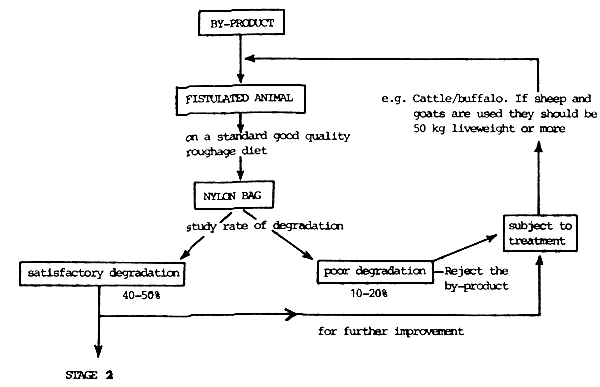
As a standard, incubate simultaneously with the unknown feed a product of known degradability which is easily reproducible (eg: leaves from leucaena or sweet potato). A detailed description of the nylon bag technique is given in Chapter 6.
Having ascertained the rate of degradation in the nylon bag, it is then possible to assess first of all whether the extent of degradation is satisfactory. If the degradation after 48 hr or so is more than 40–50% then the product is worth more consideration, and evaluations can proceed directly to Stage 2 (see Figure 3.2). On the other hand if the degradation is low (say 10–30% after 48 hr of incubation) then the product is unsuitable for feeding directly to animals.
Two options are then available depending on the local importance of the byproduct (Figure 3.1). If it is of little importance, probably the project should not be pursued further. On the other hand, if large quantities of the by-product are available, it may be justified to attempt to increase its nutritive value by chemical treatments. These are described in Chapter 6.
Having ascertained that the potential rumen degradability of the residue/byproduct is satisfactory, or that there is a need to improve it by chemical or other means, evaluation can proceed to Stage 2.
Some simple chemical analyses should be done (Figure 3.2). The most important are dry matter (DM), nitrogen (N), ash (to estimate organic matter [OM]) and lipids. Other analyses such as for cell wall constituents (Van Soest 1982) can be carried out if deemed necessary or appropriate. The most important information at this stage is simply DM, OM, lipids and N.
Figure 3.2
STAGE 2: To make essential chemical analysis
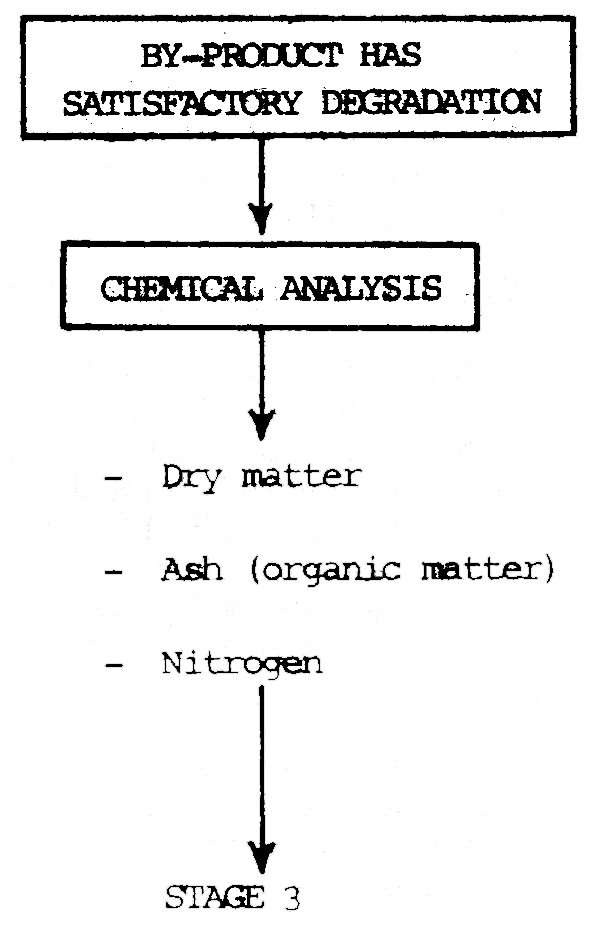
Animals which previously were fed on a standard nutritionally-adequate diet should now be adapted to eat the residue/byproduct under test. The adaptation may take two or three weeks.
Two options are possible at this point (Figure 3.3). Either the test material should be given as the only feed, or virtually the only feed (except for urea/minerals); or it should be included as one component in a mixed diet. If the product is classified in Groups 2 and 4, it may well be appropriate to use it only as a supplement at up to maybe 30% of the diet.
3.4.3.1 The byproduct as the sole feed
Intact or preferably fistulated animals can be used. Depending on the N and OM content and on the degradability of the feed resource, a mixture of urea and ammonium sulphate should be added to satisfy microbial requirements for N and S (usually in the ratio 10N:1S (eg: 5 parts urea and 1 part ammonium sulphate). Sodium sulphate can also be used as a source of S but ammonium sulphate is usually more readily available. It is worth emphasizing that fertilizer grade materials should be used in both cases.
It is best to spray the N:S mixture onto the diet in aqueous solution to ensure homogeneous distribution. The quantities can be estimated by assuming that the microbes require about 3 g degradable N/100 g fermentable OM. Trace minerals and vitamins should be added in order to ensure that the diet is not, as far as is known, deficient in any micronutrients. If there is a risk that the test material might contain some toxic element, then it should be sent to a laboratory equipped to investigate such problems.
If reasonable intakes of the diet containing the test material are obtained (at least 1.5 kg DM/100 kg liveweight/d), then the rumen degradability test should be repeated. It is often convenient , though not always possible, to use fistulated animals for the feed acceptability study, as this will save time otherwise needed to adapt new animals to the diet before the degradability test is done with the test feed providing the rumen environment (instead of the good quality feed used in the first test).
Figure 3.3: STAGE 3 To determine the degradation in diets including the byproduct
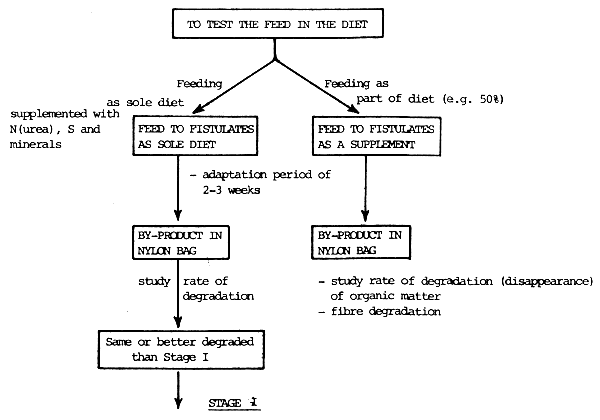
If the rate and extent of degradation are considerably less than was observed when the incubations were done in the rumen of animals receiving the standard diet, it may be necessary to supplement the test diet with up to 25% (DM basis) of an easily digestible forage (Preston and Leng 1984) or byproduct such as beet pulp (Juul-Nielsen 1981; Silva and Ørskov 1985).
3.4.3.2 The byproduct as a supplement
Byproducts used as supplements will normally be rich in fermentable N (eg: livestock excreta), or protein, oil and/or starch (eg: oilseed cakes, cereal milling offals and slaughter offal). Their role will then be to improve the rumen ecosystem, by providing nutrients/physical characteristics which will stimulate rumen microbial activity, or supply bypass nutrients. Knowledge of the origin of the byproduct, the processing it has received coupled with chemical analysis, will enable it to be categorised as either mainly a rumen activator (poultry litter) or source of bypass nutrients (eg: oilseed meals). Methods of designing trials to characterize the relative usefulness of the byproduct for these purposes are given in Stage 5.
In Stage 3 it will have been ascertained if the test byproduct is consumed in adequate quantities and that its rumen degradability is similar to that which occurred when it was incubated in fistulated animals given a high quality diet.
The next step (Figure 3.4) is to measure if the fermentable N (usually urea) is sufficient or in excess of that required. This can be done by reducing the urea supplementation to the point where degradation rates begin to decrease. It is also possible to estimate whether trace minerals are required by removing those added in Stage 3 and finding out if this makes any difference to the degradation rate. It may still be necessary to add the trace minerals to sustain the host animal's requirement rather than the microbial requirement.
In Stage 4, it is desirable to measure some parameters of rumen fermentation and function. If the test byproduct has been classified as an energy resource (Groups 1 and 3) and it is to form the basis of the diet, then almost invariably the feeding will be ad libitum. Under these conditions new feed will be offered once daily in the morning in quantities slightly in excess of the normal daily intake.
Figure 3.4
STAGE 4 Trials on rumen function
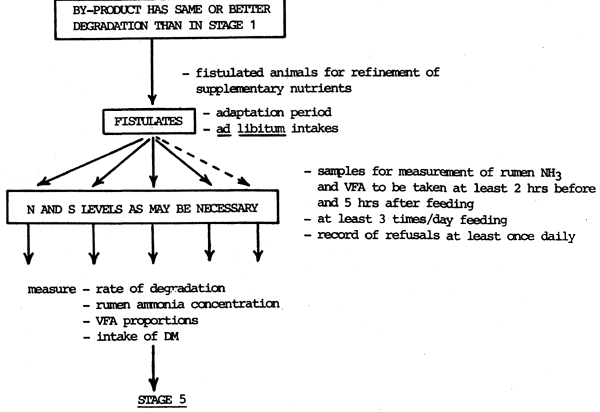
Useful parameters, measured over a period beginning before the new feed is offered and continuing for some 5 hr afterwards, are:
Rumen ammonia
Ratios of the volatile fatty acids (VFA) in rumen fluid
Acetate clearance rate
The level of rumen ammonia will indicate immediately if there is a need to provide additional fermentable N in the diet. The proportion of propionate relative to the other VFA will provide an idea of the likely glucogenic status of the end products of fermentative digestion (2.4.7). The rate of clearance from blood of an injected dose of acetate appears to offer promise as a means of predicting the adequacy of the final balance of nutrients for a particular productive function (see Preston and Leng 1986).
Stage 5 should involve experiments with intact animals (minimum of 4, preferably 8) because now it is necessary to determine what will be the level of intake when feeding is ad libitum (Figure 3.5). If the intake in cattle is less than say 1.5 kg DM/100 kg liveweight/d (2 kg DM/100 kg in sheep), then either the palatability is very poor, or more likely the diet is deficient in an essential nutrient. This could be a source of highly digestible forage (for the rumen ecosystem)or of bypass nutrients (protein is the most important) which partially or wholly escapes being degraded in the rumen (see Chapter 2 for a more complete discussion of these inputs in relation to supplementation of residues/byproducts).
A factorial arrangement of treatments should be set up employing 8 individually housed/fed recently weaned animals. The main treatments will be presence or absence of a source of locally available highly digestible green forage (eg: leucaena - or similar legume - or the foliage of cassava or sweet potato); and presence or absence of a standard bypass protein meal (fishmeal or cottonseed meal, or other oilseed meal). The arrangement of treatments will be:
The basic feed resource (residue or by-product) supplemented with urea and minerals and vitamins) (= basal diet).
The basal diet plus the green forage usually at about 20% of the diet DM (0.5 kg DM/100 kg LW/d).
The basal diet plus fishmeal (or oilseed meal) at about 5% of the diet DM.
The basal diet plus the forage plus fishmeal.
Figure 3.5
STAGE 5 Feeding trials
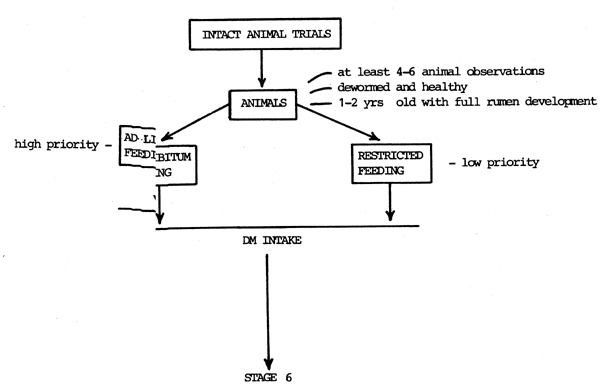
The results for voluntary intake will indicate the relative importance of either or both of these two types of supplement for the feed resource being evaluated.
If the intake exceeds 2.0 kg DM/100 kg liveweight/d in cattle (4.0 kg DM/100 kg liveweight in sheep/goats) then one can proceed directly to response trials (Stage 6) to determine the most economic amount of supplement to give according to the productive function of the target animal.
In Stage 6, as depicted in Figure 3.6, it is time to move to the target animal. The target animals can be producing different products; they can be growing and/or fattening, lactating, reproducing or working or producing wool/hair (or combinations of these activities).
There should generally be at least eight animal observations per treatment (the replications can be less when factorial or latin square designs are used; or covariance analysis is employed); and the experimental period should usually be at least 84 days (may be less in milk production trials using covariance analysis).
If the supplementation trial indicates a response in feed intake to either the forage or bypass protein supplements (or to both) then the appropriate treatments should be included in the feeding trial, using graded amounts of the particular supplement and employing usually some form of regression analysis in order to describe the response surfaces to supplementation. The wool growth assay, as a means of comparing protein meals, is an example of this approach (6.9).
Figure 3.6: STAGE 6 Production trials - (high priority)

It is assumed that the final objective is to choose a treatment method (physical, biological or chemical) that is appropriate for the particular locality. The starting point should be the optimal treatment for the residue/by-product in question, taking into account the following:
The availability of the reagent/treatment method
The cost
The risks
The feasibility of using the method at farm level
The availability of equipment required for the treatment
The efficiency of the process
The first step is to measure the improvement in degradability brought about by the treatment. The untreated and treated material should be incubated in nylon bags in the same rumen-cannulated animal given a standard diet as described in Stage 1. The degradation rate is described. If there is a satisfactory improvement due to treatment, the decision may be taken to modify the treatment, for instance to use different concentrations of chemical, or different treatment times or methods of treatment (eg: whether the stacks of straw should be covered or not).
The results of each new treatment can be measured against the optimum one. Having ascertained the most appropriate treatment to use, it is time to proceed to the next stage, namely to determine the response to improved rumen environments and to supplementation. The appropriate steps are those described in Stages 2 and 3.